Binance Review 2024: Pros & Cons and In-Depth Exchange Overview
Users located in the US and UK are not supported. For UK-based readers, we recommend checking out eToro. We have an eToro guide and sign-up link that offers a free 100k demo account. For US-based users, our eToro US sign-up link offers a free $10 crypto airdrop bonus!
Disclaimer: Don't invest unless you're prepared to lose all the money you invest. This is a high-risk investment and you should not expect to be protected if something goes wrong.

Binance is a leading global cryptocurrency exchange that offers a range of features and services beyond trading. The exchange has gained popularity due to its low trading fees and constant innovation. Binance has introduced support for fiat currencies, launched its own Binance Chain and Binance Coin, and has plans to become a decentralized autonomous organization (DAO) in the future.
Key Features:
Binance has a strong commitment to security and employs advanced risk control solutions, identity and facial recognition verification, and big data analytics to monitor transactions for suspicious activity. The exchange has also implemented a fund to reimburse customers in the event of a security breach.
In terms of regulation, Binance has faced scrutiny from regulators in the past. However, it has taken steps to enhance its regulatory framework and has obtained licenses and registrations in various jurisdictions.
Binance offers a mobile app for trading on the go, as well as a web-based platform and API access. The exchange also provides comprehensive customer support through an FAQ database, support request submissions, and online chat.
Users can participate in Binance Launchpad, the platform used to launch new tokens, and take advantage of various financial products and services offered by Binance, such as savings, staking, and margin trading.
Overall, Binance is a highly recommended cryptocurrency exchange due to its wide range of features, low fees, strong security measures, and commitment to innovation.
Binance is a leading global cryptocurrency exchange that offers a range of features and services beyond trading. The exchange has gained popularity due to its low trading fees and constant innovation. Binance has introduced support for fiat currencies, launched its own Binance Chain and Binance Coin, and has plans to become a decentralized autonomous organization (DAO) in the future.
Key Features:
Binance has a strong commitment to security and employs advanced risk control solutions, identity and facial recognition verification, and big data analytics to monitor transactions for suspicious activity. The exchange has also implemented a fund to reimburse customers in the event of a security breach.
In terms of regulation, Binance has faced scrutiny from regulators in the past. However, it has taken steps to enhance its regulatory framework and has obtained licenses and registrations in various jurisdictions.
Binance offers a mobile app for trading on the go, as well as a web-based platform and API access. The exchange also provides comprehensive customer support through an FAQ database, support request submissions, and online chat.
Users can participate in Binance Launchpad, the platform used to launch new tokens, and take advantage of various financial products and services offered by Binance, such as savings, staking, and margin trading.
Overall, Binance is a highly recommended cryptocurrency exchange due to its wide range of features, low fees, strong security measures, and commitment to innovation.

Binance is the world's most popular cryptocurrency exchange, offering top-of-the-industry security, hundreds of altcoins, and a professional-grade trading engine. Binance is home to a massive selection of crypto products, making it a robust one-stop platform for crypto enthusiasts.
Anyone involved in cryptocurrencies has likely heard the name Binance already. It’s the leading global cryptocurrency exchange, plus as you’ll soon learn in this Binance review, offers a whole lot more. Since its inception in 2017, Binance has continued to feature low trading fees and new innovations that have made it so popular in the crypto community.
In the short time Binance has been around, it has launched a mountain of new features, and it also enjoys a vibrant and active community of traders. From adding support for fiat currencies to launching its own Binance Chain and Binance Coin, the exchange is always looking for new ways to bring value to its clients. It’s even talked about morphing into a decentralized autonomous organization (DAO) in the future, which would leave its governance to the traders who use it.
Binance Review TL; DR Verdict and Summary:
Binance has held strong onto the #1 position as the most popular and successful exchange for years, dominating the crypto industry. They have been able to hold onto the top spot thanks to the following key features and strengths:
Binance Key Features at a Glance
- Largest crypto exchange in the world by trading volume and users
- Largest offering of Earn products
- Offers spot and derivatives trading, including advanced trading options and crypto loans
- Highly secure with a fund in place to reimburse customers in the event of a security breach
- Features more crypto-centric products and features than any other crypto exchange
- Low or no trading fees
- Professional-grade trading platform
- Full fiat on and offramp services
- Crypto debit card
We also have in-depth articles and guides covering various aspects of the Binance Exchange that you may find interesting:
- How to Sign Up on Binance: A Step-by-Step Guide
- Binance App review: Mobile Trading on the Go
- Binance Security Analysis: Is Binance Safe?
- Binance vs Binance US: An In-Depth Look
- BNB Coin: The Utility Coin for Binance
- Binance NFT Marketplace Review
- How to Buy Bitcoin on Binance
- A Guide to Trading on Binance
- Binance US Review
As the largest volume cryptocurrency exchange, Binance is capable of handling a massive number of trades without seeing a slowdown in its transaction times. However, it is also known for some common issues, such as unexpected maintenance and the occasional security vulnerability. Despite these things, it remains one of the top cryptocurrency exchanges. Keep reading our detailed Binance review to learn more.
Binance Key Features
Founded by the charismatic Changpeng Zhao (or simply CZ), Binance has been running for over six years as of the writing of this review. In that short time, it has established itself as a dominant force in the universe of cryptocurrencies and cryptocurrency trading. Thanks to its innovation, there’s little you can’t do at Binance in connection with crypto trading, investing or savings.
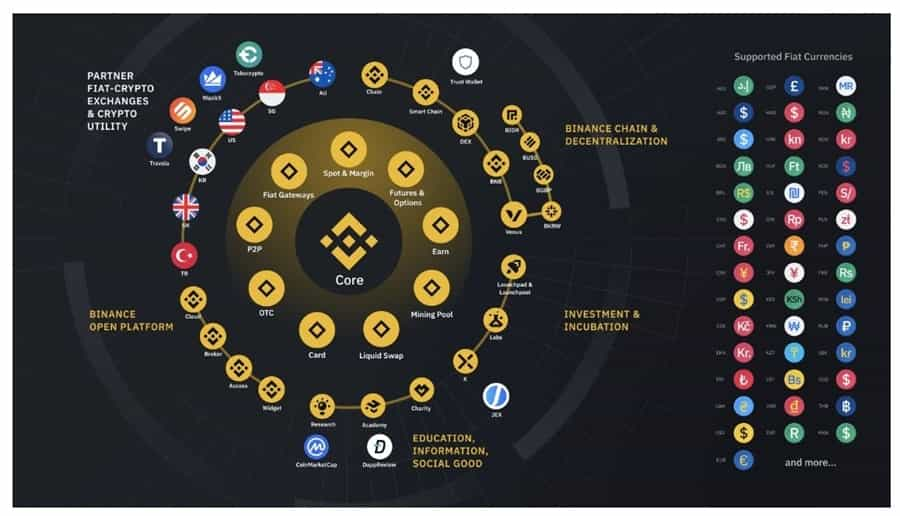
Below is a listing of the many features you can find at Binance. The list may not be exhaustive, and I’ll only cover some of these in more detail in the following Binance review, but I thought it important for you to know about as many Binance features as possible.
- Trade over 600 cryptocurrencies on Binance. Binance has one of the largest selections of quality altcoins available to trade. In addition, there are almost 1,000 pairs available to trade.
- Binance Fiat Gateway. The Binance Fiat Gateway was an excellent addition, allowing Binance users to purchase over two dozen popular cryptocurrencies with over 65 fiat currencies using bank cards and other methods. It also supports selling crypto for fiat.
- Low trading fees. Binance trading fees are some of the lowest you’ll find, plus Binance introduced fee-free trading on multiple BTC and ETH pairs
- Multi-platform support. Binance can be accessed through its web-based platform, via desktop clients for Windows and macOS machines, or through its mobile apps for Android and iOS. There’s also a Binance API available.
- Binance Futures with 125x leverage and margin trading with up to 3x leverage. Supercharge your trading with the available leverage offered by Binance.
- Around-the-clock customer support.
- Binance Launchpad. The Binance Launchpad was created as an alternative initial listing venue to the ICO model. All of the clients at Binance can take part in the IEOs on Launchpad, and they have become some of the most anticipated and profitable coin launches in the crypto industry.
- Binance Finance. Binance Finance gives crypto holders other ways to earn from their coins, such as crypto lending and staking, along with other methods for earning a passive income from crypto holdings.
As you can see, Binance has immersed itself in all areas of the crypto world. Its innovation has made it highly popular as a cryptocurrency platform, and the efforts of Binance's developers and community members consistently enhance the platform. It has become a great choice for both new and experienced cryptocurrency traders.
Note: Binance.com does not allow registration from the USA. However, if you are from the States, Binance has created an alternative platform at Binance.us. Feel free to check out our dedicated Binance US Review.
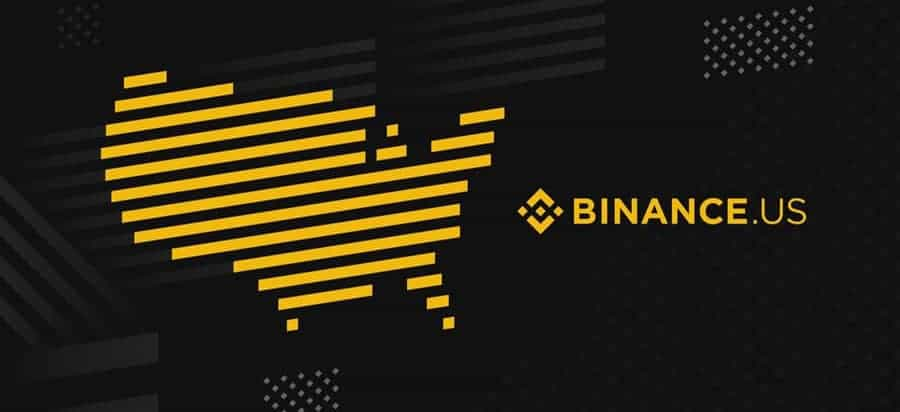
Now let’s get on to the Binance review.
Binance Review: Background and History
Binance is the world's largest and most popular crypto exchange, known for its fast, simple, robust, and intuitive cryptocurrency trading interface, which has undoubtedly fulfilled its promises.
Launched in July 2017 by its founders Changpeng Zhao and Yi He, both of which previously worked for the OKCoin exchange, Changpeng was also a member of the Blockchain.com wallet team since 2013, was educated as a software engineer at a prestigious Canadian university, and worked as a trader on the Tokyo Stock Exchange prior to founding Binance.
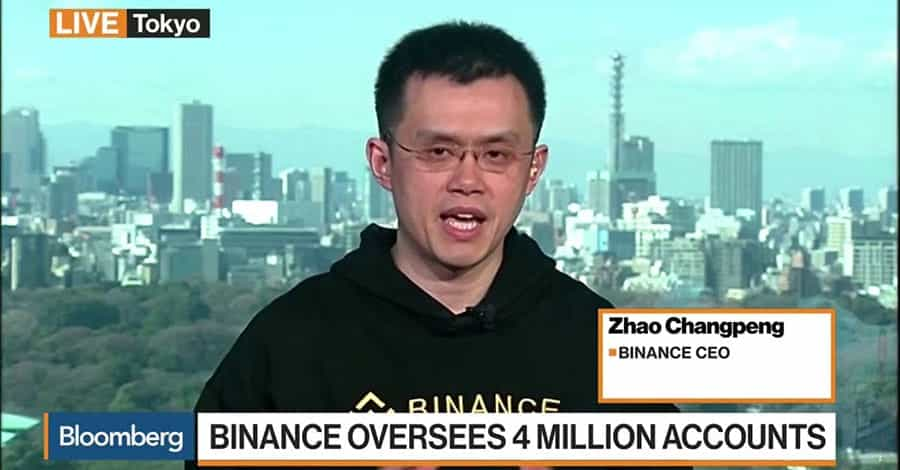
Binance's success story began with a highly successful ICO in July 2017, raising $15 million for its Binance Coin (BNB) tokens at $0.115 each. Since then, the token surged to $224 as of October 2023, becoming the fourth-largest altcoin by market cap.
With a highly successful ICO and impressive growth, Binance has become the world's largest crypto exchange by trading volume. It achieved this feat within six months of launch and maintains its position thanks to low fees, user-friendliness, robust transaction handling, and a global approach with support for over two dozen languages.
Binance doesn’t release user figures, but based on various interviews given by CZ there are now over 20 million Binance users. In addition, the exchange settles roughly $4 billion a day, with the busiest days seeing over $20 billion in trading volume. In addition, it has also created a huge suite of related products which include the following:
- Binance Academy -An open-access learning hub for blockchain and crypto education resources.
- Binance Card -A crypto payment card that can be used as a payment option for everyday purchases, just like a regular bank card.
- Binance Chain and Binance Coin (BNB) -Community-driven blockchain ecosystem with its own native token (BNB) and decentralized exchange (DEX).
- Binance Cloud -Enterprise cryptocurrency exchange solutions for cryptocurrency ventures.
- Binance Crypto Loans -A feature allowing Binance users to take out crypto loans secured by your cryptocurrency assets.
- Binance DEX -Binance’s decentralized exchange built on the Binance Chain.
- Binance Fiat Gateway -A fiat gateway that lets you purchase cryptocurrencies using various fiat currencies (currently supports 65 fiat currencies.)
- Binance Futures -Binance’s crypto-derivative platform that lets you trade futures with up to 125x leverage.
- Binance Labs -Binance’s infrastructure impact fund and initiative to empower blockchain projects.
- Binance Launchpad -Binance’s crypto crowdfunding platform for launching initial exchange offerings (IEOs). Binance innovation made Launchpad the first crowdfunding platform for IEO’s in the industry.
- Binance OTC - Over-the-counter trading desk for whales and other large-volume traders.
- Binance P2P trading -A peer-to-peer crypto trading platform like LocalBitcoins or LocalCryptos that supports payments via WeChat, AliPay, Bank Transfers, and QIWI.
- Binance Research -Institutional-grade research platform conducting analysis for investors in the crypto space.
- Binance Savings -Ability to employ your crypto assets by lending them out to earn interest. You can withdraw your funds anytime.
- Binance Staking -Binance staking feature lets you stake certain cryptocurrencies and enjoy an annual yield on supported cryptocurrencies.
- Binance Marketplace - Binance offers a platform where users can spend their crypto holdings on real-world services like flights and hotel bookings with partnered sellers.
- NFT Marketplace- Binance is the best place to find NFTs on the Binance Chain. Explore it further in our Binance NFT Marketplace review.
Many of the features were developed by Binance, but they have also made a large number of acquisitions to help bootstrap their growth. Some of the largest were the acquisition of WazirX, India’s largest crypto exchange, DappReview, a Chinese dApp analytics platform, Trust Wallet, one of the most widely used self-custodial crypto wallets, and CoinMarketCap, the cryptocurrency market data aggregator.
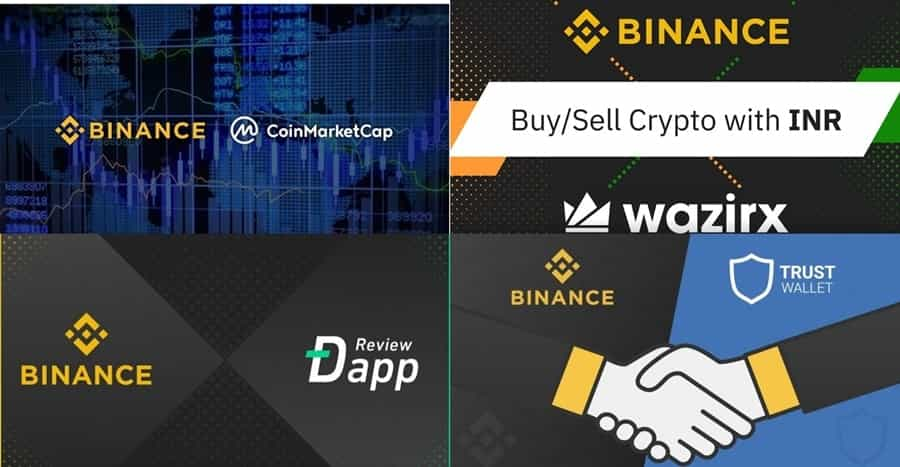
Future plans include morphing the Binance exchange into a decentralized autonomous organization that will be governed by the community.
Binance Locations
Even though Binance was founded in China, it didn’t stay there for long. Just a couple of months after its founding, it moved its headquarters from China to Japan to avoid upcoming regulatory changes banning cryptocurrencies in China. A year later, Binance opened offices in Taiwan and announced it was moving to the island of Malta, where cryptocurrency exchanges are more welcomed.
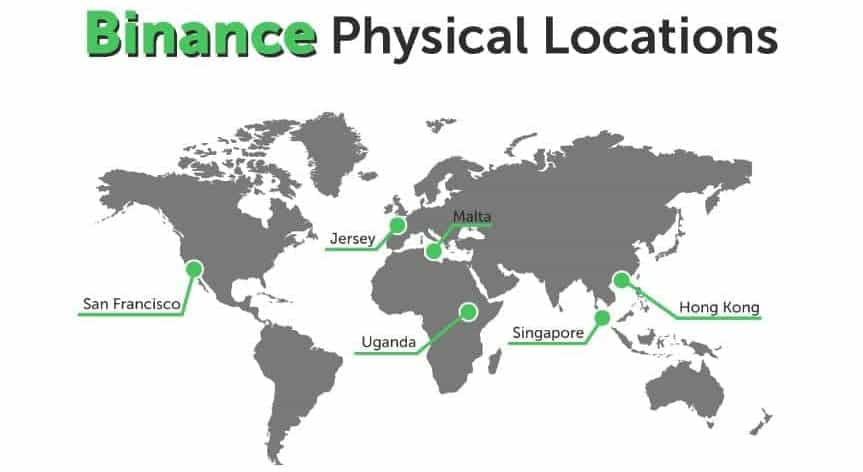
Locating Binance's headquarters can be quite a challenge, resembling a game of Whack-A-Mole. However, it is worth mentioning that Binance maintains offices in various cities such as Bahrain, Dubai, and Paris. Additionally, they are expected to unveil a single global holding location in the near future. In terms of legal entity registration, Binance has completed the process in Italy and has intentions to bolster their local team in that region. Craft.co indicates that Binance's corporate headquarters can be found in the Cayman Islands, with additional strategic locations in Vilnius, Lithuania, and Malta.
In addition, there are a number of other offices located all around the globe including those in California (United States), London (United Kingdom), Berlin (Germany), Moscow (Russia), Istanbul (Turkey), New Delhi (India), Manila (Philippines), Ho Chi Minh (Vietnam), and several other locations across Asia. In total, the Binance team operates in over 40 countries, with the platform available to users in over 180 countries.
Any verification procedures or requirements are based on the jurisdiction of the trader. First-time customers will go through the typical Know-your-Customer (KYC) verification process which requires the new client to submit the following documents:
- Government ID document (passport, ID or driver’s license)
- Residential address document (utility bill)
The verification process is quite straightforward and typically completed quickly. You can learn more about the sign-up process in our Signing Up For Binance: Step-by-Step Guide.
Is Binance Safe?
With the need for ID verification, it’s normal to wonder if Binance is a safe exchange. As the largest crypto exchange in the world, Binance has taken the time, effort, and money to harden its security. And our Binance review has support for the security of the Binance exchange.
Binance utilizes artificial intelligence risk control solutions that are state-of-the-art and uses both identity and facial recognition during the sign-up process. In addition, they also use big data analytics and cyber forensic investigations to monitor each transaction taking place on the exchange. All of this helps to identify any suspicious or irregular activity occurring on the exchange.
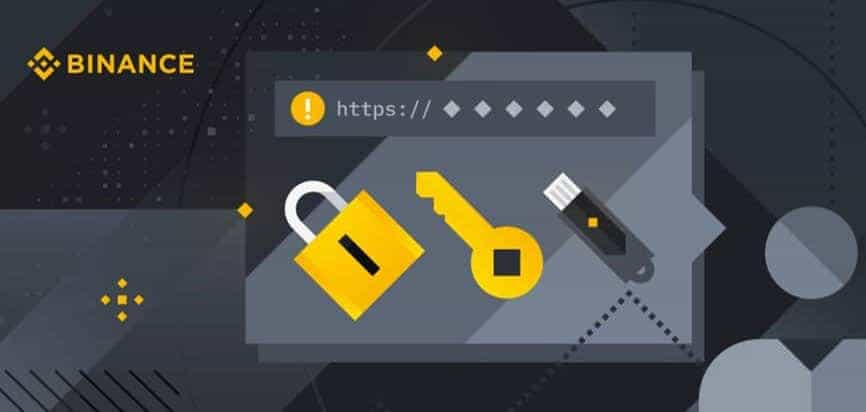
Thanks to all this security, it’s been some time since any hacking attempts at Binance have been successful. In fact, the last successful hack at Binance was in May 2019 when hackers were able to use an attack that relied on phishing, breaking the 2FA, and accessing a Binance hot crypto wallet. Fortunately, all customers were reimbursed thanks to the Binance SAFU insurance fund.
We won't go into much detail about Binance's impressive approach to security in this article as we have a dedicated Binance Security Analysis piece which covers Binance Security if you'd like to know more.
Binance Security Summary:
Binance is a secure exchange and has established itself as a leader when it comes to security approaches with concepts like Proof of Reserves. The platform has taken great lengths to enhance its security and as of 2024, it is one of the most secure crypto platforms available.
Proof of Reserves
In light of what happened with FTX, Binance’s CZ suggested that crypto exchanges should implement some measures to assure customers of the safety of their funds. Proof-of-Reserves was mentioned as a necessity to be implemented by exchanges.
If you’re not sure what it is, it’s basically an algorithmic program that allows customers to verify their funds are on the exchange. It involves the usage of a Merkle Tree to do the verification.
How Do Users Verify on Their Own?
Customers can log into their Binance account, click on “Wallet” and then “Audit” to obtain their own Merkle Leaf and Record ID. These two pieces of information are used together with the audit date selected to view the audit type, what assets are covered for the audit and the asset balances at the time of the audit.
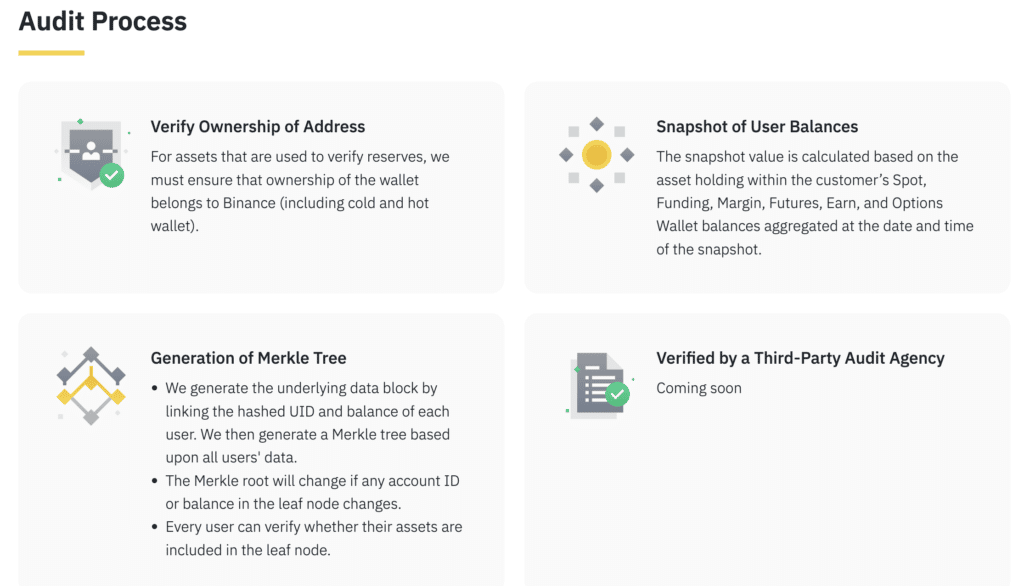
Binance also offers customers the opportunity to independently verify the hashes generated by the Merkle Tree but this involves some basic understanding of coding or how programming works. Even if you were to follow the step-by-step instructions on their page, you’d still need to know what you’re looking at. This option is mainly for those who are knowledgeable about programming.
The Controversy
The above seems like a safe way for customers to know that their funds are safe. However, there are a few points of note:
- Only selected assets are covered by the audits. At this time, only Bitcoin can be verified. CZ mentioned more assets in the coming weeks.
- Binance’s version of Proof of Reserves does not seem to cover the liabilities. It also doesn’t have an auditor (yet) to verify the assets. This was called out by Jesse Powell, Kraken’s Ex-CEO, and one of the exchanges to provide Proof -of-Reserves as early as Dec 2021. Others also joined him in the space.
Without these two elements, what is offered by Binance seems more like a sleight-of-hand than actual verification of funds. This was conveniently highlighted by a tweet from the community:
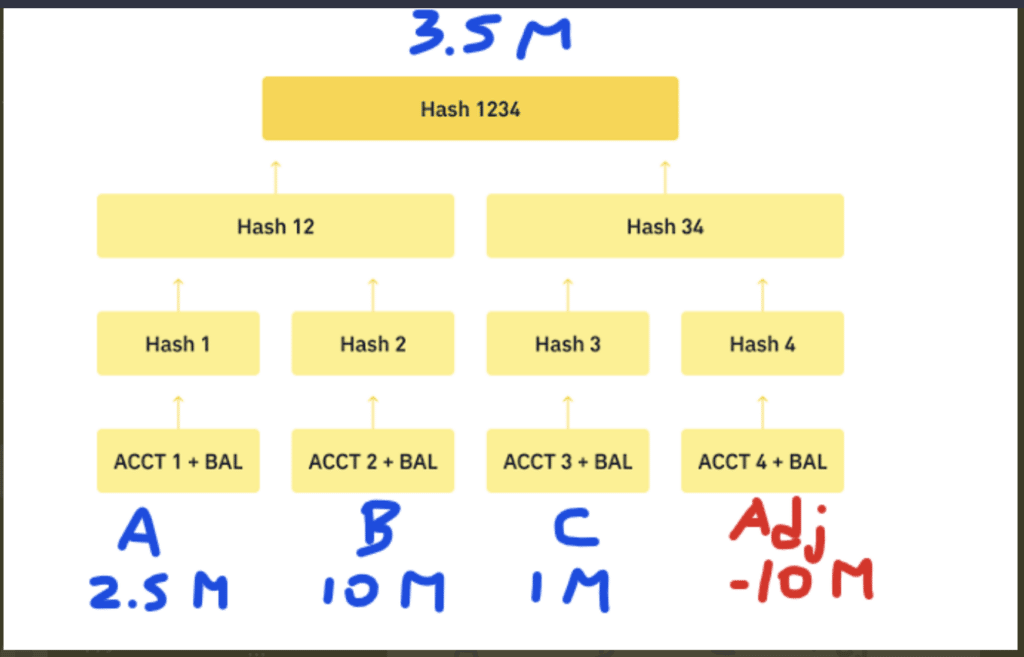
All of this is to say that customers shouldn’t be too easily fooled by what is presented by the exchanges, not just Binance alone. It’s important to get to the heart of the matter, which is:
- Are my funds actually held in the exchange?
- Does the exchange have enough cash to cover all withdrawals from all customers in a few days?
Whatever proofs that are offered need to be able to answer both questions above squarely and clearly. If you’d like to see how Binance stacks up in this area as compared to other exchanges, please check out Nic Carter’s webpage as it’s the current gold standard in this matter.
Binance vs. SEC
In November 2023, Binance agreed to pay $4.3 billion to the US government in one of the largest penalties the federal government has ever obtained from a corporate defendant. Importantly, Binance admitted to breaking the law, a mostly uncommon practice in white-collar crime and one that's reserved for the most serious cases.
According to the US Justice Department, Binance admitted to engaging in anti-money laundering, unlicensed money transmitting, and sanctions violations. The department also imposed a monitorship as well as reporting requirements on Binance as part of the resolution. Zhao, more commonly known by his initials CZ, also admitted to felony charges for failing to maintain an effective anti-money laundering program. As part of CZ's settlement, he agreed to step down as CEO.
The resolutions closed the curtain on investigations by the Department of Justice, the Commodity Futures Trading Commission, the Office of Foreign Assets Control and the Financial Crimes Enforcement Network.
Richard Teng, the global head of regional markets at the time, was handed over the reins of the world's largest exchange with immediate effect. He has a wealth of financial services and regulatory experience.
In response, Binance said the settlement removes a major overhang.
When Binance first launched, it did not have compliance controls adequate for the company that it was quickly becoming, and it should have. Binance grew at an extremely fast pace globally, in a new and evolving industry that was in the early stages of regulation, and Binance made misguided decisions along the way. Today, Binance takes responsibility for this past chapter. - Binance
In an exclusive interview with The Coin Bureau, new CEO Teng admitted that Binance had “inadequate” controls for its size and that the exchange took “certain misguided decisions.” He said the exchange focus is not only becoming user-focused but also a “compliance-led” company.
There has also been some chatter online regarding whether Binance can even afford to pay the hefty fine. “We can pay those fine without any problems,” Teng remarked. He said conversations with VIP clients have been “overwhelmingly positive.”
J.P. Morgan said the settlement is a positive not only for the exchange but the wider crypto industry.
Binance Regulation
Tying into the safety concerns at Binance are obviously questions regarding the regulatory status of the exchange. Traders feel much safer when there’s some third-party regulation ensuring a safe trading environment and no bad behaviour on the part of the exchange. And when cryptocurrencies are concerned, we know that most exchanges operate without any regulation.
For years there’s been the idea that Binance is licensed and regulated in the jurisdiction of Malta. However, in February 2020, the Malta Financial Services Authority (MFSA) released a statement that said Binance is not regulated in Malta by the MFSA.
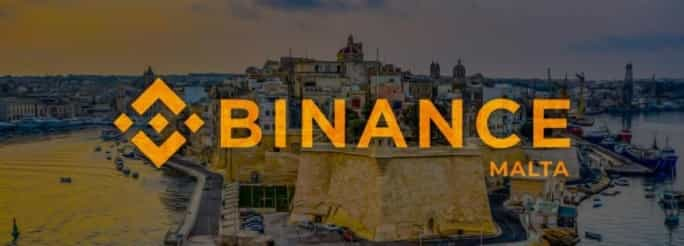
Once that was clear, it was also clear that the parent company Binance was not regulated by any specific regulatory agency, nor were they licensed in any jurisdiction. However, some of the subsidiaries of the parent company are regulated by the specific country in which they operate. For example, in the U.S. Binance.us is registered with the Financial Crimes Enforcement Network (FinCEN). It is also licensed to operate in most (not all) U.S. states.
Binance UK is operated by Binance Markets Limited and is regulated by the UK Financial Conduct Authority.
After a bit of concern and controversy, it is good to know that Binance took regulation and compliance seriously and enhanced its regulatory framework. As of 2024, Binance is fully regulated in France as a Digital Assets Provider, authorized by the Autorité des marchés financiers (AMF) with the approval of the Autorité de Contrôle Prudentiel et de Résolution (ACPR).
Then, there's Russia. Binance was said to be considering withdrawing from the country amid U.S. sanctions stemming from the country's invasion of Ukraine. The exchange limited P2P trading services in Russia, telling users they can only exchange tokens for rubles.
Here's a full list of licenses and/or registrations held by Binance:
| Europe | France, Italy, Lithuania, Spain, Poland, Sweden, Kazakhstan |
| Commonwealth of Independent States | Kazakhstan |
| Middle East | Abu Dhabi, Bahrain, Dubai |
| Asia-Pacific | Australia, Indonesia, Japan, New Zealand, Thailand |
| Americas | Mexico, El Salvador |
| Africa | South Africa |
Binance Coin Support
One of the most popular features of Binance that have attracted so many traders is the wide variety of coins they support. There are currently over 600 coins supported and nearly 1,000 trading pairs. So, not only can you trade BTC and other cryptocurrencies against the USD, you can also trade it against the Euro, the British Pound, Tether, BNB, and more.
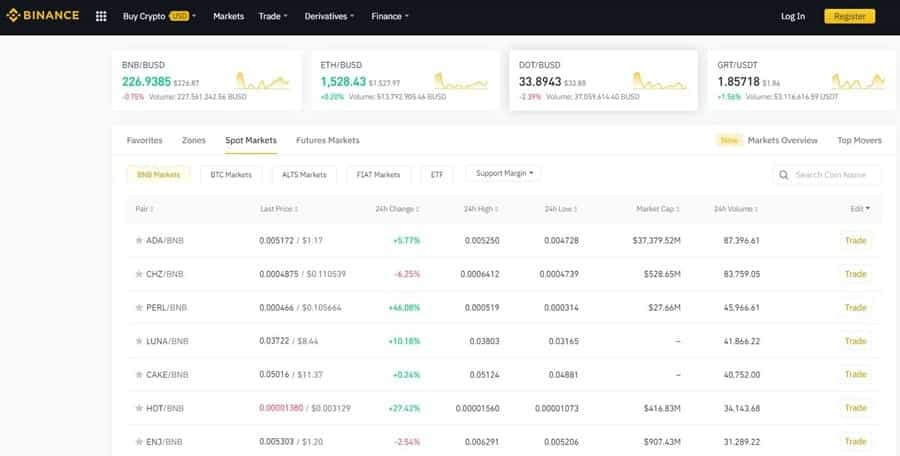
There are also a good number of tokens offered on the Binance platform, and the IEOs from Launchpad make it to the Binance exchange immediately following their release. Binance is also pretty quick to add new coins immediately following their initial offering on other platforms. That means traders can often buy newly issued tokens at low prices.
Binance Fiat Support
Binance has multiple payment methods and offers its users the most options to buy crypto out of all the crypto exchanges. Supporting over 65 fiat currencies, along with payment options via debit card, credit card, bank transfer, and more, users are spoiled for choice, though it is important to note that the options available vary by jurisdiction.
Users who have access to buy cryptocurrencies through Binance will see the “Buy Crypto” link at the top of their account page when logged in. Clicking it will take you to the fiat-to-crypto service page.

Binance Fees (and how to reduce them)
Binance charges no transaction fees at all for crypto deposits, but the same can’t be said for actual trades and for withdrawals. Even so, the trading fees at Binance are some of the lowest in the crypto industry, plus there are ways to make them even lower still.
Binance fees work on a tiered structure with trading fees being dependent on 30-day trading volume as shown below:
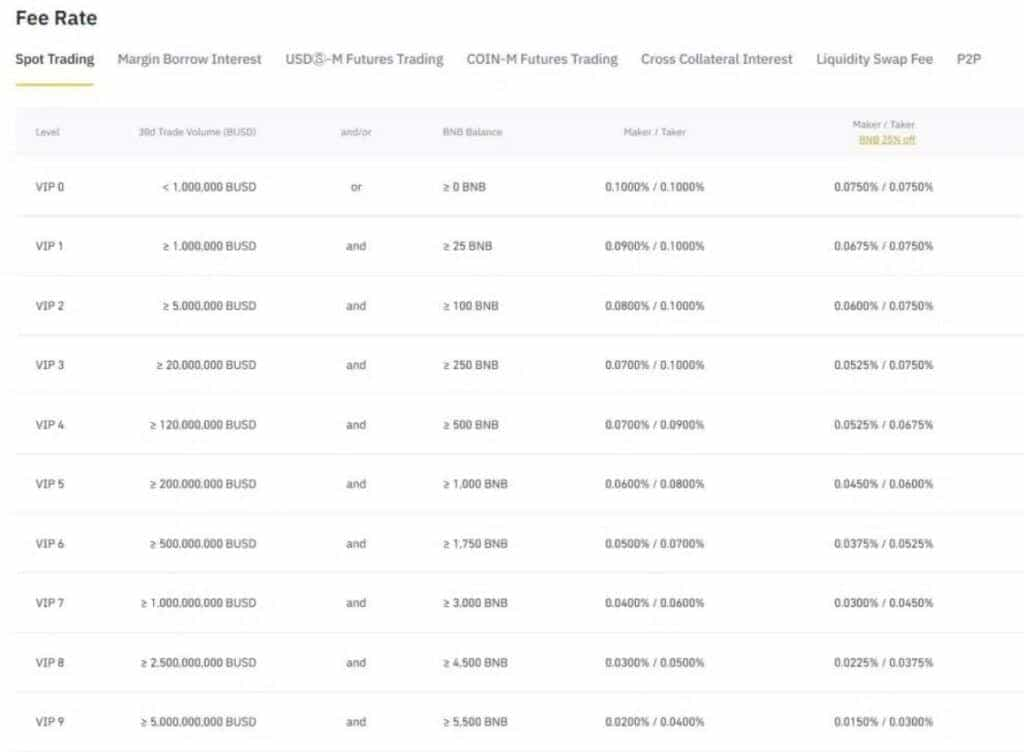
To sweeten those low trading fees even more, it’s possible to get a significant discount (up to 25%) on your trading fees if you use Binance Coin (BNB) to pay the transaction fees. You can get another significant discount (up to 25%) for referring your friends to Binance.
And as if those rock-bottom fees aren't low enough, Guy even managed to sweet-talk the folks over at Binance to give our community an exclusive discount. Users who sign up with our Binance sign-up link can get up to $600 and will receive a 20% fee discount for life!
Binance futures continue the theme of low trading fees with a 0.02% maker fee and a 0.04% taker fee.
Another key factor to look at when evaluating Binance’s fees is futures funding rate and margin position daily interest rate. These tend to change based on market conditions, and there are no fixed rates, but you can follow the links above to see the current rates.
Then there are the withdrawal fees to consider. With withdrawals, Binance offers remarkably good value for money. Note that withdrawal fees do vary from cryptocurrency to cryptocurrency, but that’s hardly unusual. A small sample of the fees for some of the more popular coins is shown below:
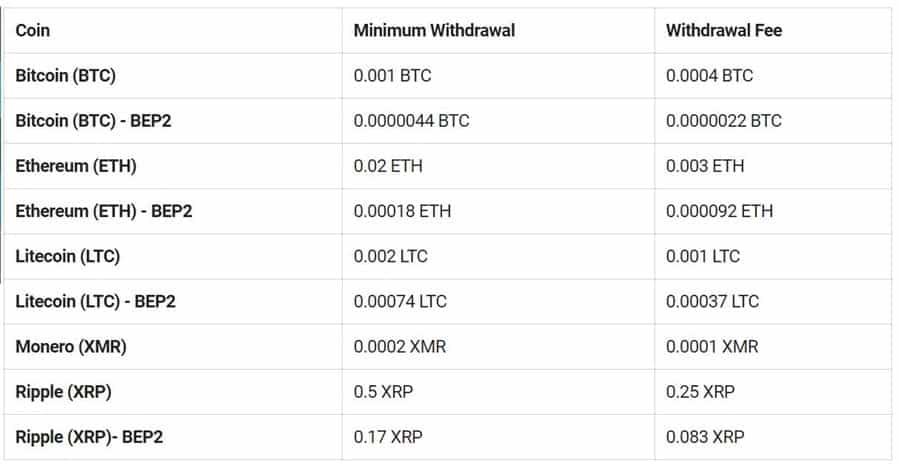
As you can see, Binance lets its users withdraw either regular or BEP2 versions of their assets. BEP2 withdrawals are based on Binance Chain and use not an actual crypto asset, but a pegged BEP2 version of it.
There are also transaction fees to consider if you’re using the Binance Fiat gateway, and these aren’t inconsequential. While you can buy over two dozen cryptocurrencies with over 65 different fiat currencies through the Binance Fiat Gateway, the fees you pay are going to vary based on the payment method used, and on the floating exchange rate charged by whichever payment processor is used.
As a rough guide, these fiat-to-crypto gateway fees range from 0% to 7% depending on the payment method and processor. Note that bank card transactions are the most expensive and Binance offers many zero-fee deposit options on bank deposits.
Binance Fees Summary:
Overall, you’ll find that Binance has some of the lowest fees in the industry, which is quite refreshing and is probably another reason why they were able to become so popular and grow so quickly. After all, who wants to pay more in trading fees when they don’t have to?
Binance Registration and KYC
You are required to create an account to use the Binance exchange, but the process is pretty simple and straightforward, requiring the uploading of a government-issued photo ID and proof of residence.
Feel free to refer to our Signing Up For Binance: Step-by-Step Guide to get the ins and outs of registering for a Binance account.
Binance Deposits / Withdrawals (Fiat & Crypto)
Deposits
Funding an account at Binance is as easy as logging into your account, and clicking through the “Funds” > “Deposits / Withdrawals” link at the top of the site. You can then search for the currency you are planning to deposit and when you click the “Deposit” button you’ll be given the appropriate crypto wallet address or banking details for over 65 fiat currencies. Deposit methods include bank card, bank deposit, wire transfer, Apple Pay or Google Pay depending on the currency selected. Binance recently struck a partnership with MoonPay to support USD deposits.
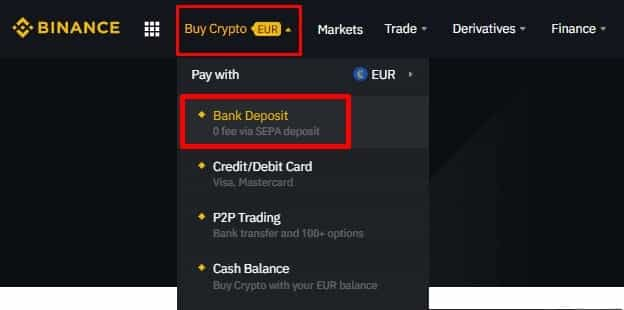
For crypto deposits, once you have the internal wallet address, you can begin transferring cryptocurrency onto the platform to trade with. Note that network fees and transfer times will depend on which cryptocurrency you’re sending since each blockchain has different block times and different network costs. You can learn more about that in our Guide to Crypto Network Fees.
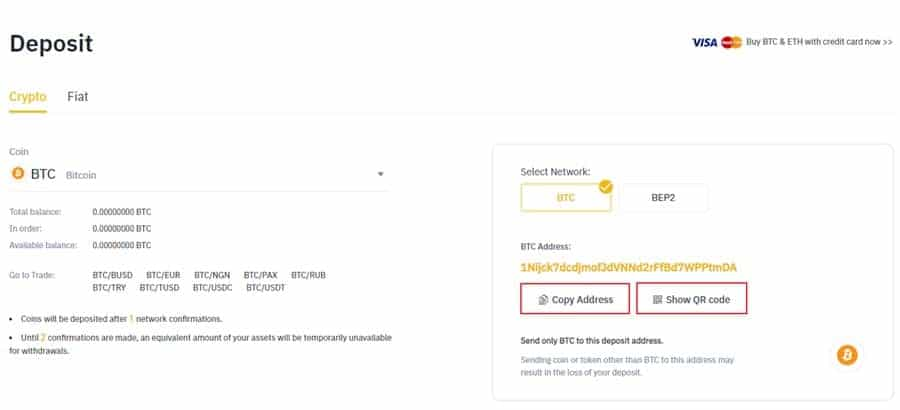
Once you’ve transferred some coins and Binance has received them, or you've swapped some of your fiat for crypto, you can go right ahead and begin trading any of the nearly 1,000 cryptocurrency pairs offered on the exchange.
Withdrawals
Binance has made crypto and fiat withdrawals easy. For crypto withdrawals, you’ll once again visit the “Funds” link in your account and then go to “Withdrawal”. This is where you’ll be able to choose the coin you are withdrawing, fill in the amount you’d like to withdraw, and then provide the external wallet address that the funds should be delivered to. Click the “Withdrawal” button and then all you need to do is wait for the transaction to be verified on the blockchain to show up in your wallet.
To withdraw money, simply enter your bank account details, or if you funded your Binance account with a bank card, in some cases, you can withdraw fiat back onto the same card, but bank transfers are typically the preferred method. Fiat withdrawals typically take 1-4 business days
Binance Trading Platform
Our Binance review found that one of the features of the Binance platform is the simple and intuitive trading platform they’ve created with multiple options and assets to choose from.
The most basic trading interface is the “Convert” platform. Here the trader simply chooses the cryptocurrency input and the desired output currency and makes the trade. There are no charts, order books, or fees. Here is what the Convert screen looks like:
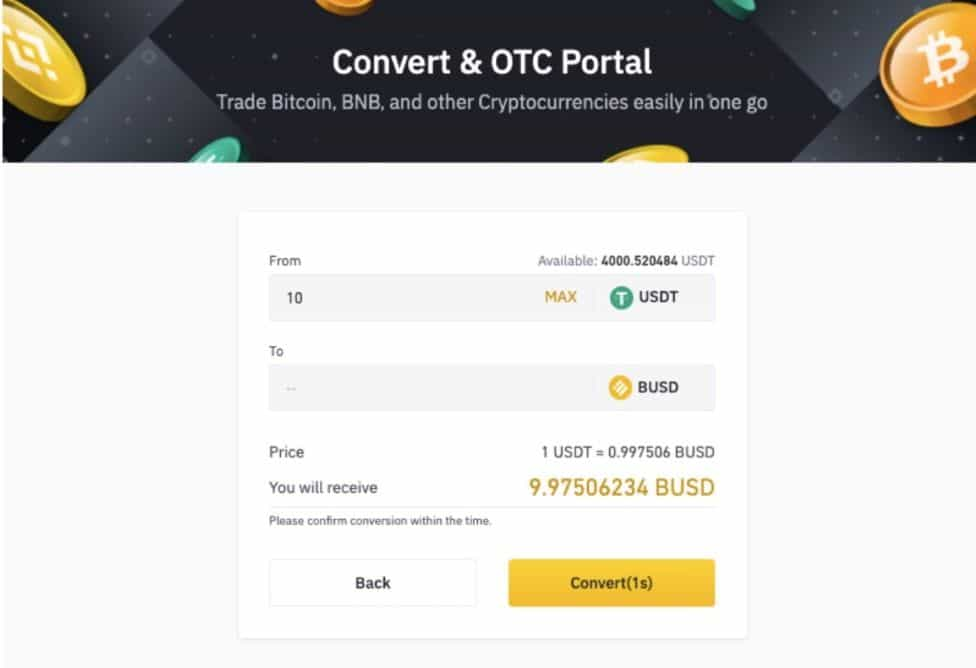
This is an over-the-counter crypto market. There is a spread between buying and selling prices, but this is pretty tight for most popular pairs that have good trading volume. In addition to the 48 cryptocurrencies available in the Convert platform, there are also five fiat currencies to choose from – EUR, GBP, BRL, TRY, and AUD.
The “Classic” trading platform is the original charting and volume display. It gives traders a good deal more information about the activity in the pair they are planning on trading. It also gives full access to all of the cryptocurrencies and trading pairs available on Binance. New traders could be overwhelmed when they first access this platform, but once they use it a few times it becomes easy to see what information is being presented, and how to use the platform most efficiently.
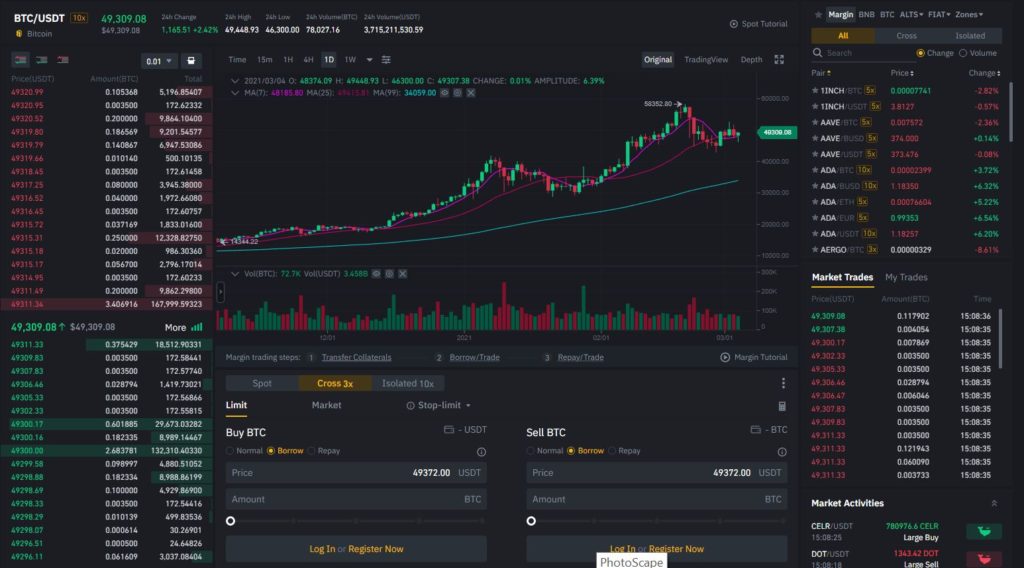
There’s also an “Advanced” charting option, but to be honest we actually find this to be cleaner and less cluttered than the Classic interface. It features the Order Book, which can be a valuable tool for experienced traders. There are also a wide variety of technical analysis tools and indicators that can be applied to the trading charts.
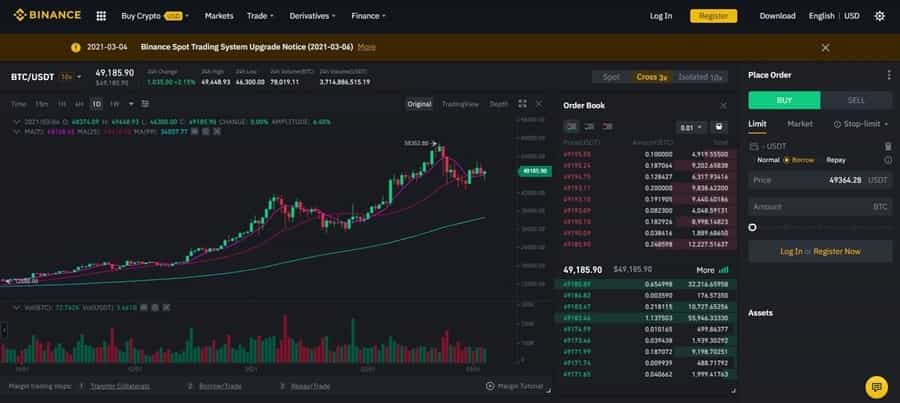
The "Margin" option under the Trade link filters trading pairs with available margin. If you turn off this filter, you'll still see pairs with margin trading, indicated by a small 3x, 5x, or 10x icon. Keep in mind that cryptocurrencies are highly volatile, capable of significant daily percentage swings. Using margin can amplify both returns and losses significantly.
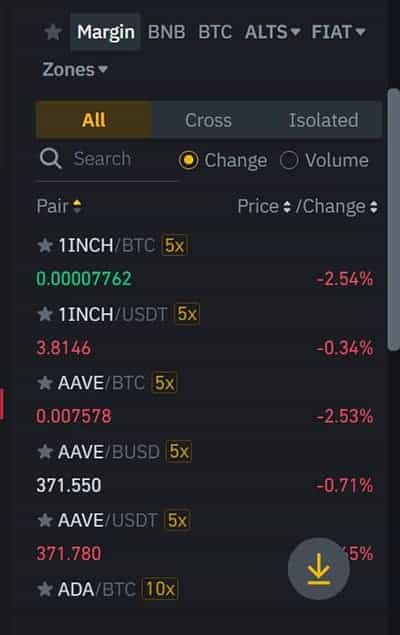
Finally, there is a link to the Binance peer-to-peer trading platform, where you are able to make deals directly with other Binance users to exchange cryptocurrencies and pay using your bank account or a number of online e-wallet services. There are nearly 200 different payment options to choose from when using Binance P2P.
Binance's spot trading fees and margin trading fees boast a tiered approach where the more you trade, the lower your fee gets.
For more on Binance trading, feel free to check out our Binance Trading Guide.
Warning⚠️ Margin trading is very risky and is a tool best used by professional traders. Be sure to fully understand how margin and leverage work before participating in margin trading.
Binance Futures
Not content with spot and over-the-counter trading? Then Binance has derivatives for you. Traders can choose from perpetual contracts that never expire on dozens of coins and tokens.
Launched in August 2020, the futures trading platform is enjoying increased popularity because it allows for leverage of up to 125x on futures contracts. These contracts come in two varieties – USDT-M futures and COIN-M futures. In addition, Binance Futures also has a copy trading feature that allows users to automatically mimick real-time contract trading strategies of top-performing traders.
USDT-margined futures are similar to traditional standard futures, margined and settled with a fiat currency, for delivery of a commodity or asset such as gold. COIN-margined futures are margined and settled with the asset instead (i.e. Bitcoin or altcoin), and are designed after “inverse” contracts which are counterintuitive in traditional finance.
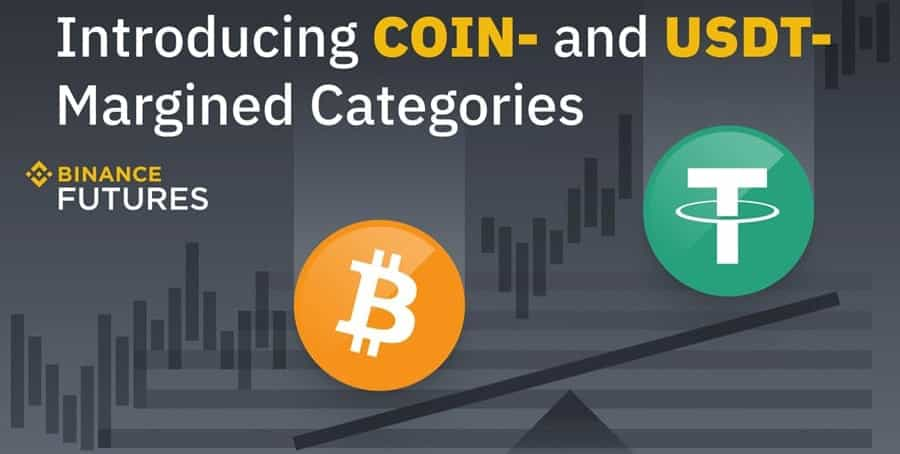
Known as ‘Binance Perpetual Futures Contracts’, these operate in a similar nature to conventional futures. However, the key difference is that the contracts never expire. As a result, the trade will remain in play indefinitely until you:
- Close it manually
- Your stop-loss or take-profit order is triggered
- You are liquidated (more on this below)
Obviously, the top draw for these derivatives is the leverage that’s made available. If you aren’t familiar with leverage, it is a function that allows you to enter larger positions than you could otherwise given your available funds. The 125x leverage offered by Binance is huge when you consider that in Europe and the UK leverage on cryptocurrency CFDs is capped a 1:2 for retail traders.
However, the derivative products offered by Binance fall outside of these restrictions, not least because you are trading digital contracts that in theory – do not exist. As a result, Binance allows you to trade with leverage of up to 1:125 on Bitcoin and other altcoin futures.
For those who are unfamiliar with how leverage works in practice here’s an example trade that will illustrate how dramatically the rewards and risks can add up.
Binance Leveraged Trade Example
Note that when actually trading at Binance everything will be priced in the respective base currency (e.g. Bitcoin), but for this example, I am using USD to show the reality of the risks more clearly and concretely.
Let’s assume you have an account at Binance and there is $1,000 in the account that you are willing to risk on leveraged futures trading. You believe that Bitcoin is currently oversold and will soon rise, so you go long on the BTC/USDT futures contract using the full 125x leverage available to you.
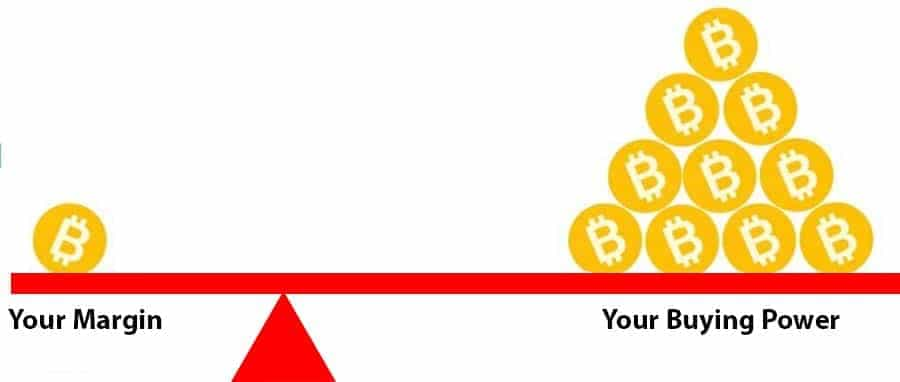
To be clear from the start, your $1,000 trade using 125x leverage means the value of your trade is $125,000 and both your gains and losses will reflect this value.
- If BTC/USDT increases by 10% you would have made $100 by trading your $1,000 stake normally.
- However, since you are using 125x leverage on the trade your profit with a 10% gain in BTC/USDT would be $12,500 since the price change is multiplied by 125x.
That’s really an amazing trade that would take your Binance account balance from $1,000 to $13,500. However, imagine if BTC/USDT declined by 10% instead.
- Ordinarily, at a stake of $1,000, a 10% reduction in the value of BTC/USDT would result in a loss of $100.
- However, you are using 125x leverage so just like the winning trade you’ll see your losses magnified by 125x. That means this trade will cause you a loss of $12,500.
Of course, you could only lose that much if you actually had that much money available in your margin account. Otherwise, the position would have been closed as soon as the futures contract moved 0.8% against you ($8 x 125) unless you deposited more money in your account to cover any potential additional losses.
Derivative trading is a sophisticated and advanced trading technique. While the notion of multiplying your gains by 125x may sound very attractive, it is balanced by the risk of potentially losing everything in your account if a trade goes against you.
Binance Leveraged Tokens
Binance Leveraged Tokens are a type of derivative product that gives you leveraged exposure to the underlying asset. Like other tokens, leveraged tokens can be traded on the spot market. Each leveraged token represents a basket of perpetual contract positions. The price of a leveraged token moves along with price changes in the perpetual contract market, and the leverage level moves up and down accordingly.
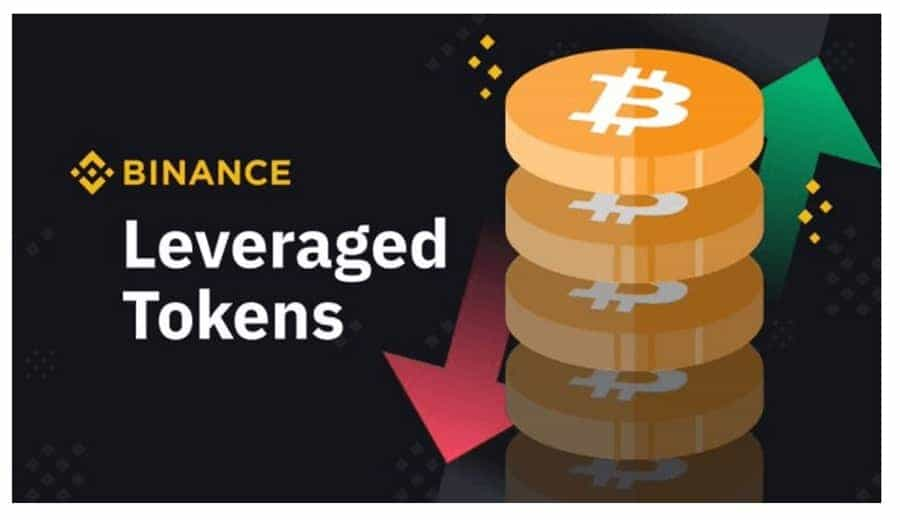
Unlike margin trading, leveraged tokens allow you to gain exposure to leveraged positions without having to put up any collateral, maintain a maintenance margin level, or worry about the risk of liquidation.
However, even though you don't have to worry about the risk of liquidation, there are still risks associated with leveraged token positions, such as the effects of price movements in the perpetual contracts market, premiums, and funding rates.
Binance Debit Card
With the growing popularity of crypto debit cards, Binance wasn't going to sit this one out. Binance has launched the Binance debit card that provides users with cashback built on Visa, which is accepted by over 60 million merchants worldwide.
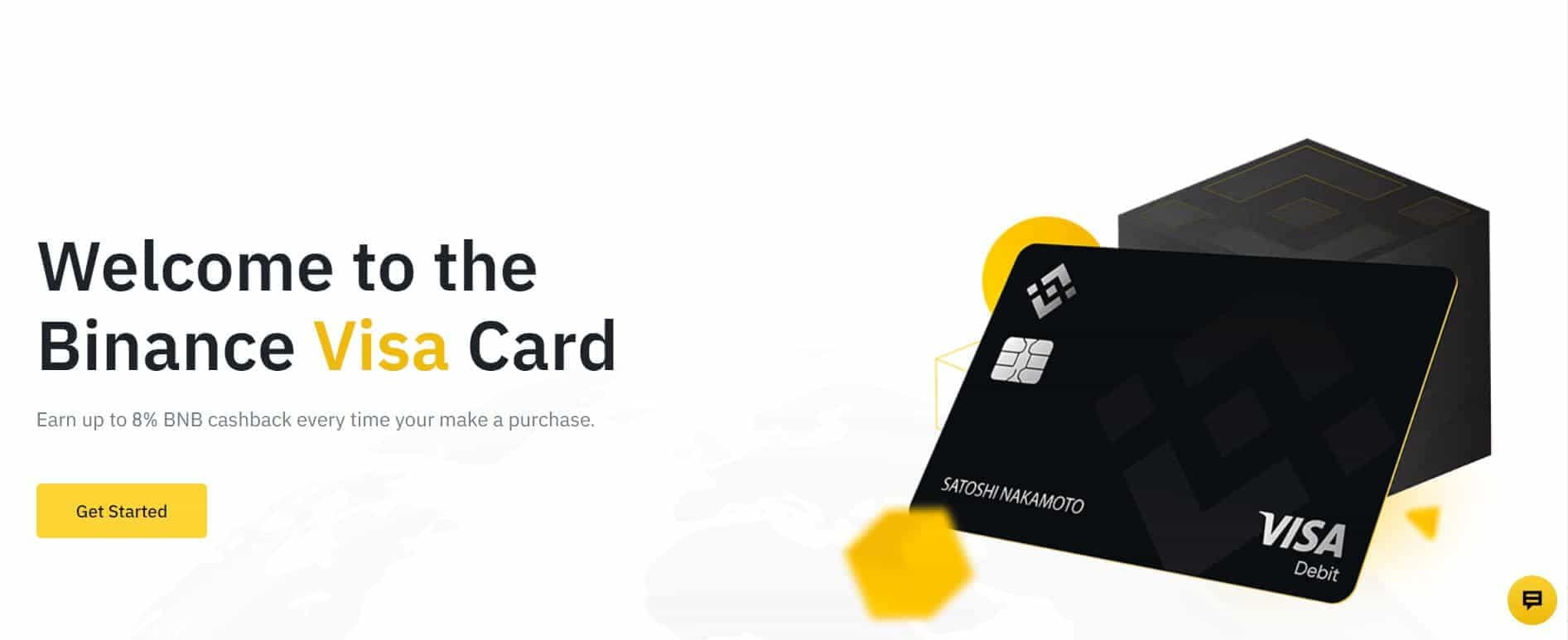
This card offers users up to 8% cashback in BNB on every purchase and is supported by Google Pay and Samsung Pay. The cashback is paid daily and is deposited directly into the customer's Funding Wallet. The Binance card has a great fee structure, as in, there are no fees to use the card which is nice to see:
- No card issues fee
- No signup fees
- No annual fees
- No account inactivity fees
Though there is up to a 0.9% fee for ATM withdrawals, and if you lose the initial free card there is a 25 Euro replacement fee to get a new one.
The cashback percentage that customers receive depends on the amount of BNB the customer holds in their Binance account. The amount of BNB held is calculated on a monthly average and takes into consideration the average holdings of BNB in held in the customer's Binance wallets for a period of 29 days before yesterday. Here are the current card levels:
| Card Level | BNB Monthly Average Balance | BNB Rewards for Your Purchases |
| 1 | 0 | 0.1% |
| 2 | 1 | 2% |
| 3 | 10 | 3% |
| 4 | 40 | 4% |
| 5 | 100 | 5% |
| 6 | 250 | 6% |
| 7 | 600 | 8% |
All customers need to do to spend with the card is top up their Funding Wallet with supported fiat and/or cryptocurrencies, use the card like any other bank card and they automatically earn BNB cashback. The cryptocurrencies currently supported for purchases are: BNB, USDT, BTC, SXP, ETH, EUR, ADA, DOT, LAZIO, PORTO, SANTOS.
One coin missing in that is the BUSD stablecoin. After Paxos, the issuer of BUSD, was ordered by a New York regulator to stop minting the coin, Binance said it would end support for the stablecoin. As of Sept. 6, BUSD was no longer a loanable asset, and Binance ceased withdrawals of Binance-peg BUSD tokens via BNB Chain, Avalanche, Polygon and Tron on Sept. 7. The exchange will continue to support BUSD trading until February 2024, but it would no longer list any new trading pairs involving BUSD.
Also, in a post on X (formerly Twitter), the exchange said it would discontinue its crypto-backed debit card in Latin America and the Middle East on Sept. 1. Without providing a reason, Binance said the move would affect less than 1% of its users in the regions.
Nevertheless, having a debit card linked to your crypto is great. Next, we're hoping for a Binance credit card. Maybe it won't be too far off?
Binance Apps
Besides trading on the web-based app, you can also download a mobile version of the app for either Android or iOS operating systems. There are a number of benefits to using the mobile version of Binance, along with a few disadvantages:
Advantages
- Convenient when away from your computer;
- Instantly access altcoin markets anywhere, anytime;
- Fast trading and analysis.
Disadvantages
- Limited charting and analysis tools;
- Not good for large trades or deep market analysis.
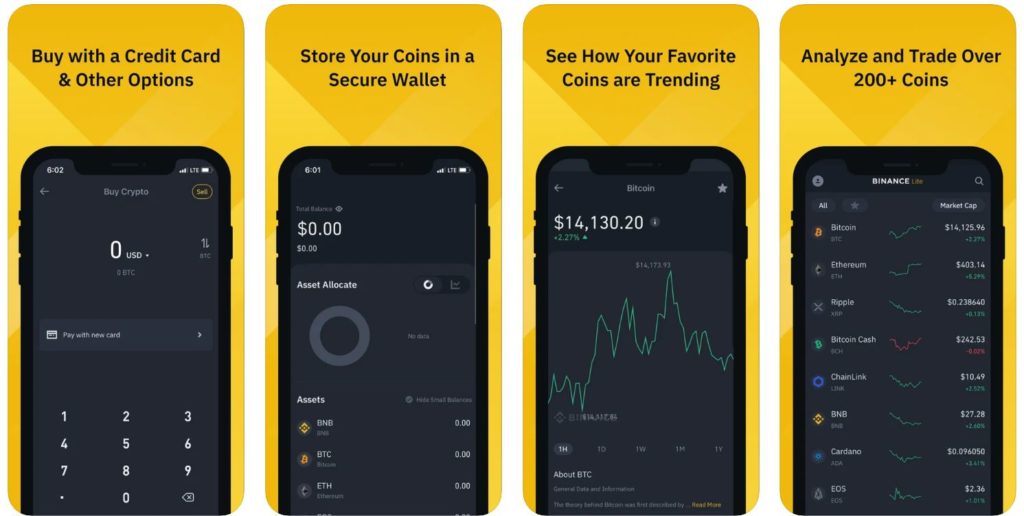
You can learn more about the Binance app in our Binance Mobile App Overview.
Binance Coin (BNB)
Another notable feature of Binance is their own cryptocurrency, the Binance Coin, or BNB. As of October 2023, the BNB token is the fourth largest cryptocurrency by market cap and they are valued at $224 with its all-time high coming in at $676 in 2021. Talk about an incredible return from its ICO price of $0.115.
The primary function of the BNB token is not speculation (although many use it for that). Instead, it is meant to be used to pay for and reduce trading fees and unlock additional perks and benefits of the site. It will also feature heavily in future plans to create a Binance DAO, where it will be used in the governance of the DAO.
Binance supports the value of BNB by buying and burning BNB tokens on a quarterly basis. By burning tokens, Binance decreases the supply and makes the remaining tokens more valuable.
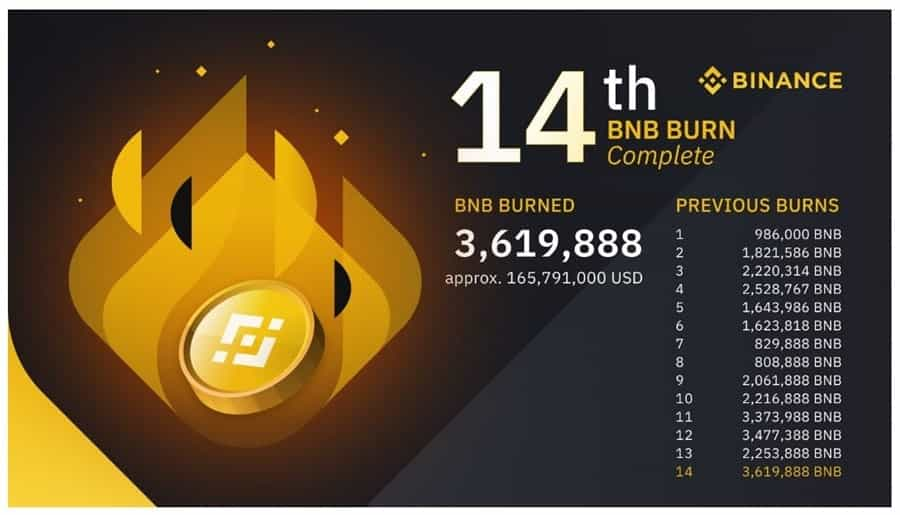
After the 14th BNB burn, Binance CEO Changpeng commented that the burn rate of BNB will be accelerated.
Over the last three and a half years, we have burned about 13% of the promised amount, with a total USD equivalent value (nominal) of $426,304,000. Even though this is an impressive amount for a three-year-old startup, at that rate, it would take roughly 27 years to finish the burn. So, we thought it’s time we speed it up a bit. Exactly how much faster? We are not 100% sure. The current accelerated burn would put the trajectory to be around 5-8 years to finish the 100 million BNB. But a number of factors could change the accelerated part in the future, including BNB price fluctuations, overall market conditions, and more.
You can read more about BNB and its core role in the Binance ecosystem in our BNB Coin Review.
Binance Chain
In September 2020 Binance launched its own low-fee, high-performance blockchain that’s compatible with the Ethereum Virtual machine. The chain was originally launched as the "Binance Smart Chain" (BSC) but rebranded simply to the Binance Chain (BNB Chain) in 2022. The solution is just one more innovation in blockchain technology and this one is meant to solve the issues in decentralized finance, such as slow transactions and expensive gas fees. With the Binance Chain, developers are free to focus on innovating rather than worrying about the gas costs of their dApps.
The Binance Chain has grown at an astounding pace, often seeing nearly the same amount of network activity during peak times as on Ethereum. The Binance Chain has over 1200 projects with the average gas cost of around $0.035 per transaction (as of this writing Ethereum gas prices are over $20 per transaction). The number of unique addresses is reaching over 230 million and the average daily transaction total is nearing 2.5 million.
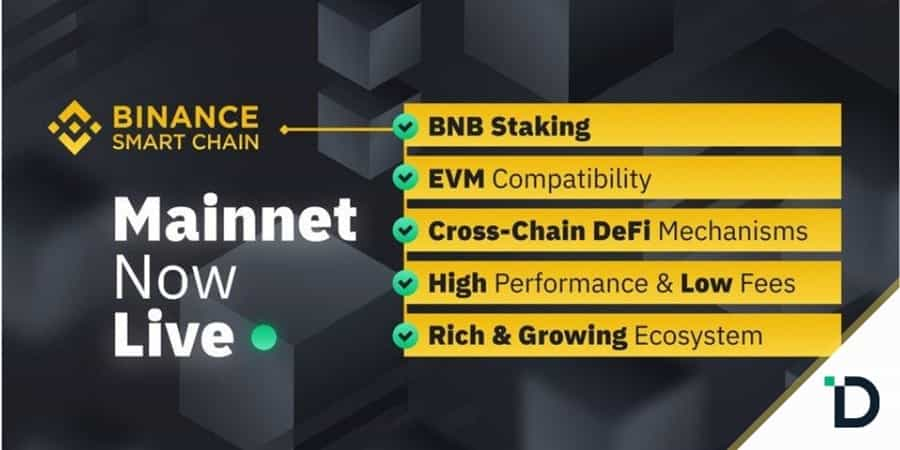
Binance has been focused on the growth and innovation around liquidity pool and AMM recently, and there have been a number of innovations built on BSC that take advantage of this. One of the most notable of these is PancakeSwap, a Uniswap clone that gives users some innovative new ways to yield farm and create other income streams.
Other excellent DeFi-focused products launched by Binance include DeFi staking and the Binance Liquid Swap. And there are quite a few more which you can learn about in the following section.
Binance Finance Products
In addition to providing trading and exchange services, Binance has also expanded to offer decentralized finance products. These include staking, savings, farming, and other financial services tied to the Binance ecosystem and/or the Binance Chain blockchain.
Binance Earn
Binance Earn is similar to savings on the blockchain, and there is no relationship between this product and trading. Instead, it includes savings products that fall under flexible ARY, fixed APY, and high-risk products. Basically, these products pay out an interest rate similar to a savings account, or the dividends you might receive from owning certain stocks. Among all the major crypto exchanges, Binance offers the most robust Earn section with an impressive variety of options to choose from. In a bid to include more utility for BNB, Binance offers dedicated BNB-specific investment products, like the BNB Vault.
Flexible Terms
The Flexible Terms accounts have interest rates and supported assets that change over time with current interest rates ranging from 0.1% to 6%.

The flexible savings also includes the Binance Launchpool, where you can stake BNB tokens to earn some of the newest tokens that have been launched on the Binance Launchpad.
Finally, there is the BNB Vault. BNB Vault is a BNB yield aggregator. Depositing BNB means participating in Launchpool, Savings, Defi staking and other projects and at the same time gaining rewards.
Fixed Terms
There are also higher rates available on three stablecoins (USDT, and USDC), but it is required to lock them up for a period of time. These locked tokens earn a set rate over the period of time they are locked.
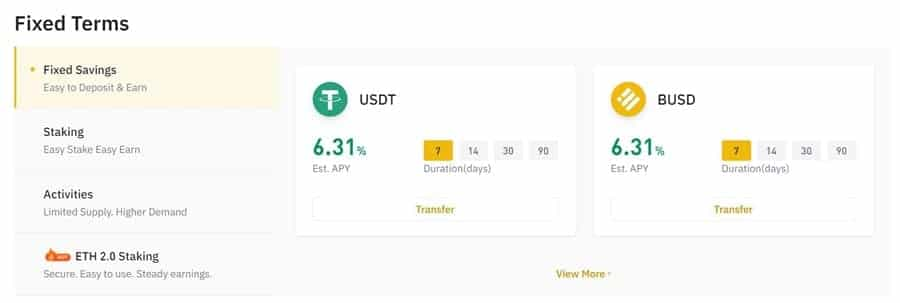
In addition to these, there are also 41 PoS staking coins that can be locked for a set period to earn a set, fixed interest rate. Also, there are 178 “Activity” products, which are similar to farming pools and offer much higher interest rates.
High-Risk Products
The main high-risk product being offered is DeFi staking, which is a form of providing financial services to users through smart contracts. Existing DeFi projects aim to provide higher annualized earnings for specific currencies.

Also offered is the Dual Investment Pools. Binance Dual Investment lets you deposit a cryptocurrency and earn yield based on two assets. You commit your crypto holdings, lock in a yield, but earn more if the value of your committed holdings increases. It's basically a way for you to have more control over your risk.
Finally, users can provide liquidity to pools and earn based on the liquidity being provided. While this seems like it should be risk-free it is actually high-risk. This is known as Impermanent Loss.
Adding liquidity into a liquid pool and becoming a liquidity provider is not risk-free. When the market price of tokens fluctuates greatly, the staking income may be lower than the income of ordinary holding of the tokens, and losses may even occur.
Other Financial Services
- Binance Pool – Supplies mining services, with an emphasis on Proof of Work and Proof of Stake. Basically, it uses auto-switching to move mining power to the highest value chain at any time.
- Binance Visa Card – With the Binance Visa Card, you can convert and spend your favourite cryptocurrencies at more than 60 million merchants worldwide. Just transfer crypto from your spot wallet to your card wallet, and you're ready to go. EUR, BNB, BTC, ETH, and SXP are all supported and the card is available in most EU countries.
- Crypto Loans – Clients can apply for loans using their crypto assets as collateral, with loan terms from 7 to 90 days. Initial LTV is 55%.
- Liquid Swap – A liquidity pool that traders can either contribute to or use to swap two tokens/fiat assets. Adding liquidity into a liquid pool and becoming a liquidity provider is not risk-free.
Send Cash
Binance launched Send Cash in Latin America, a new product that will allow users to transfer crypto via Binance Pay from nine countries in the region. The product will be available for Binance users in Colombia, Honduras, Guatemala, Argentina, Costa Rica, Paraguay, Dominican Republic, Panama, and Mexico to transfer their crypto through Binance Pay to send funds to recipients with bank accounts in Colombia and Argentina
Binance Launchpad
The Binance Launchpad is the platform used to launch new tokens. Its goal is to provide a wider audience for new projects, while also providing the cryptocurrency community with the due diligence to vet these projects prior to launching the tokens.
Binance Launchpad was one of the first crowdfunding token sale platforms, having launched itself back in December 2017. It has had many successful token launches and is considered to be the most reliable platform for profitable initial offerings. The platform also uses the native BNB token as a way to participate in the Initial Exchange Offerings.
Token Offerings on Binance Launchpad
Binance continues to attract a significant number of users specifically so that they can participate in the new token launches. Those who wish to take part in any token sales do need to complete the KYC verification process as all token sales are carried out in compliance with local jurisdictions.
By visiting the Binance Launchpad website users can see what new projects are coming up, and what the terms of the token sale will be.
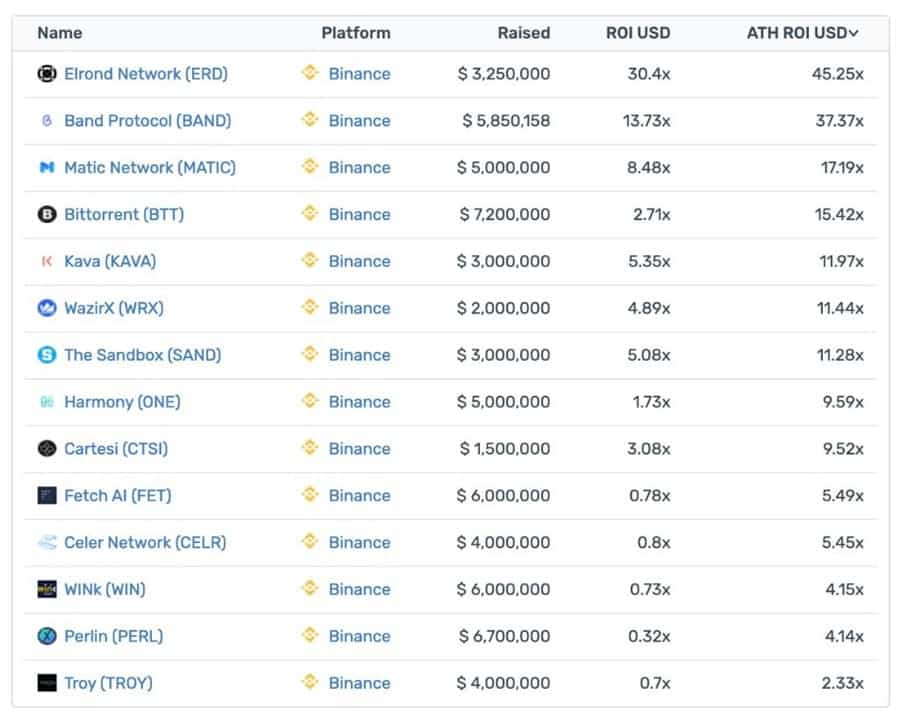
Initial Token Offerings on Binance Launchpad use a lottery system for subscribing to the token sale.
Binance Customer Support
Binance has one of the most comprehensive and detailed FAQ bases of any exchange or cryptocurrency project we’ve come across. You can find the answer to most questions in this database, although it might take some searching. In addition, you can submit a support request to the support team through the link at the FAQ database.
Binance also has an online chat function that can be accessed directly through the trading platform.
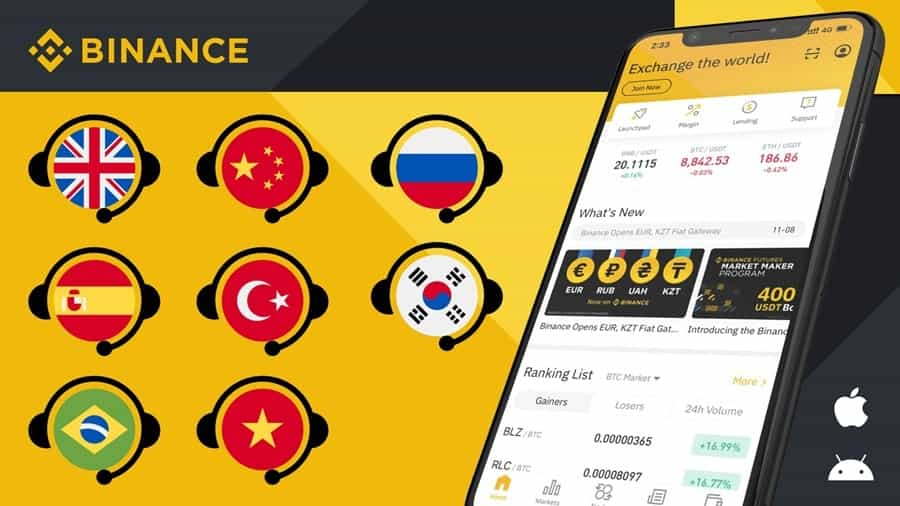
One customer service aspect Binance lacks is telephone support. This can make Binance seem less responsive, but in looking around most cryptocurrency exchanges fail to provide telephone support. Even the more mainstream CFD exchange platforms rarely provide telephone support any longer.
Crypto exchanges aren't generally known for having good customer support, but fortunately, the support at Binance is quite good and very responsive. That said, during peak periods there are delays experienced by many users in receiving support. Still, the Binance support team is acknowledged as one of the better support experiences from the major crypto exchanges in the industry.
Binance Promotions & Competitions
Binance is quite well-known for its promotions and competitions, which have become very popular among the Binance community. It’s no surprise that these competitions increase the stickiness of the exchange, and encourage increased trading. It’s a method of gamification that we’ve seen work well in many industries.

Anyone interested in seeing what the latest promotions are can do so at the Binance Latest Activity Announcements. Here is a look at previous competitions to give you an idea of what to expect.
- Binance Futures Launches Mondays & Tuesdays Bounty Promo
- SAND Trading Competition - $50,000 in SAND and Limited-Edition NFTs to Be Won!
- Binance Futures Spring Tournament - Over $1,600,000 to Be Won!
As you can see, there is ample chance to win just by using Binance as your exchange of choice. New promotions and competitions are launched constantly, and on any given week you’ll have a chance to participate in a fun competition and win some valuable prizes. If trading contests and "vegas-style" games are something you are interested in, other leading crypto exchanges that are strong in this feature are KuCoin and Bybit.
Binance vs Other Exchanges
Although Binance is the most widely adopted crypto exchange in the world, that doesn't necessarily mean it is right for everyone. We have a dedicated article comparing the top exchanges in different categories to help you on your search to find the right crypto exchange for you:
And you can also check out our Binance vs series where you can see how Binance stacks up against the competition:
Binance Review: Conclusion
There are so few downsides to the Binance platform and so many features that it is easy to recommend using it as a primary cryptocurrency exchange, which is why Binance also made our list of the Top Cryptocurrency Exchanges. You’ll get the lowest fees in the industry and one of the widest selections of coins and products to choose from on your crypto journey.
Plus, you can explore the rest of the Binance ecosystem, which includes pretty much everything in the universe of blockchain and cryptocurrencies. In fact, it might be fair to say that if there is a feature or product on another exchange that Binance doesn’t already have, there’s a very good chance they are working on it or going to release a bigger and better version.
Frequently Asked Questions
Yes, Binance is one of the largest and most trusted crypto exchanges. They are working with global regulators and authorities to further legitimize themselves and work within the confines of rules and regulations.
Binance follows best practices in terms of security protocols, and they keep a significant portion of profits aside as an insurance fund for customers who lose funds in the unlikely event of a hack. Binance also offers substantial security features which the user can deploy on their accounts for added safety. Binance is often considered one of the safest exchanges in the industry.
No, the Binance exchange is not a wallet. It is primarily an exchange where customers can hold funds in a “wallet” section of their account, but this is not the same as a non-custodial crypto wallet. Binance does offer a mobile browser extension wallet similar to Metamask which can be downloaded and used as a traditional crypto wallet.
We believe so. Binance is trusted by millions of users worldwide and the insurance fund has been used for customer account breaches in the past. Binance continues to work towards transparency and global regulation and is a good driving force for the crypto industry as a whole.
Yes, as with all crypto exchanges, hacks are never 100% impossible which is why it is important not to keep significant portions of your funds on any exchange. Best practice is to use a non-custodial crypto wallet to move your funds off an exchange for long-term holding.
Binance has set up Binance.US for American-based customers.
There is no guaranteed time, but verification on Binance can take anywhere from 1 to 10 days. The most common time frame from our own experience and reviews shows that 48 hours is about average.
Binance is available in most countries around the world, while Binance.us was set up to serve the American crypto market. Binance is the more comprehensive platform, with more features, products, and better coin support, making it the better exchange for users not located in the United States. Binance.US is one of the best choices for US-Based users.
Yes. Depending on location, customers can withdraw crypto and withdraw money via bank card or bank transfer/bank wire.
Yes. Binance has a very large selection of crypto assets. It is one of the most popular crypto exchanges for buying Bitcoin and other major cryptocurrencies.
Buying Bitcoin on Binance is incredibly easy. We have an entire article dedicated to How to Buy Bitcoin on Binance
While we cannot provide financial advice, the BNB token has performed extremely well and is firmly placed in the top ten cryptocurrencies. Long-term investors in BNB are confident in the future strength of the Binance platform, which directly correlates to the strength of the BNB token.
Binance USD (BUSD) is a USD-pegged stablecoin on Binance. You can read more about it in our BUSD review.
Binance’s location has an interesting history. They were originally based in China but moved out due to increasing crypto scrutiny in the country. Binance had no official location or headquarters for years, but is now headquartered in the Cayman Islands and Seychelles with a strong presence in the United Arab Emirates which helps with regulation and global compliance requirements.
Disclaimer: These are the writer’s opinions and should not be considered investment advice. Readers should do their own research.


